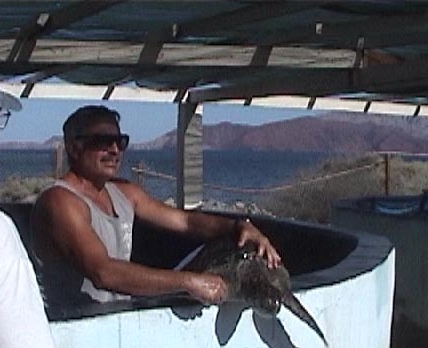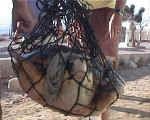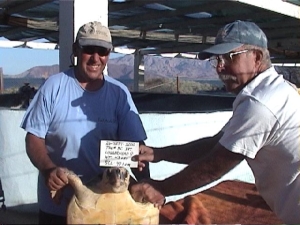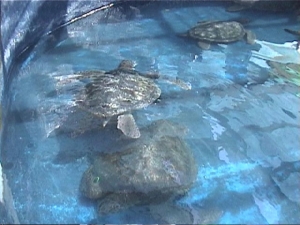

Log 6: Summer in the Sea of Cortez
The Turtle Farm
Here is some interesting information from Grover aboard "Koloa Kai". Grover helps during the summer and is excited about the possibility of their 200th turtle-tagging in the summer of 2001.

Antonio Rescindez head of the Turtle Station, with one of the clients.
Betty the satellite-tagged Loggerhead turtle we released into the Pacific Ocean on 2-9-2000 at Santa Rosealiita has given us her first location. She has traveled 58.2 NM as of 8-9-2000 in a SSW direction. We are hoping that she will head for Japan to chase some males!! If you want to follow her on the net look at whale.wheellock.edu. Another turtle named "Yamalet" has been swimming for 12 mo. toward Japan. You can follow her progress at the ccturtle site.
See you down the water-way. Aloha Grover S/V Koloa Kai!
Click on any thumbnail to see the full-sized photo.
Patti and Bill of "Good Medicine" were kind enough to document a day at the Turtle Farm.
Report from: TURTLE RESEARCH STATION: BLA
Seadate: September 26, 2000, 2100 UTC, Bahia de Los Angeles
A truly unique experience was enjoyed by local Sea of Cortez cruisers Beth and Larry from REASON, Les from GEMINI, Toby, Chris, and Stephen from DREAMWEAVER, Grover from Koloa Kai, and Patti and Bill from GOOD MEDICINE, when they joined Antonio Rescindez at the Sea Turtle Research Station to volunteer and assist with data collection. The turtles needed to be weighed, measured, checked for any bites or sores, and photographed. The team set up two tables, and with the patient guidance and advice from Antonio, established an assembly line, with Chris and Stephen retrieving the turtles from the tank, handing them over to Bill and Larry where they were weighed and measured, with Beth and Patti documenting. Then they were moved them to the next table for photographs taken by Grover, with Les and Toby positioning and holding the turtles. Those turtles are strong! The largest was a 108 lb female Loggerhead,just ahead of the 99.5 lb male Black Sea Turtle, both challenges for Chris, who was doing most of the lifting and hauling out of the tanks.
Antonio and Grover provided us with history, biology, physiology, and psychology lessons as we worked. Most interesting to me is the fact that the turtles go into a type of hibernation, staying under water for as long as one month in the winter time. Researchers have tried to learn how the turtles can do this, but so far, the puzzle is unsolved. Retrieving blood samples to identify red to white blood cell ratios may help, but it has so far been impossible to locate the hibernating turtles to get the samples. The research station was established 20 years ago, funded by grants and donations. Antonio is always in need of volunteers, and wishes there were more researchers interested in turtles. His enthusiasm for his work is incredible. But one can sense his frustration about how the turtle's numbers are dwindling, victims of fisherman's nets, poaching and the Mexican's love of turtle meat. It is not illegal for Mexicans to catch turtles, but Antonio would be happy if this custom disappeared.

Toby, Les & Steve use all their might to hold this turtle still for a photo opportunity.
Who do you think would win in the long run?
There are a myriad of research topics, including the study of the turtle's migratory patterns, nesting habits, diet, health problems, measuring intelligence, and environmental impacts. The turtles are all tagged, and several have been fitted with tracking devices and cameras to document the turtle's travel. One turtle was recovered in Japan, caught by a fisherman. "Betty", named for Antonio's wife, was released a few weeks ago and is now just north of Turtle Bay, a renowned poaching area. We all wish Betty fair winds and following seas to safely help her move out of that area. We all agreed that it would be fun to stay longer to help Antonio with his work, but many of us are continuing our way south as hurricane season starts to wind down.


After documenting the turtle's vital statistics, the crew returns them to the tank before releasing them again.
We left Antonio and the Turtle Research Station as the sun was disappearing behind the mountains. Antonio let us know how much he and the turtles appreciated our help, but we certainly were the ones who gained in knowledge, understanding, and respect both for the untiring work of the researchers, but also for these extraordinary creatures.
The turtle station at Bahia de Los Angeles capured an olive ridley. She was trying unsuccessfully to nest next to the turtle station. She was measured , tagged and released. Other days are for whale shark identification, weather permitting. We welcome visitors and are sure you will gain new insight into these amazing creatures.

[ Our Boat & Crew |
Family & Friends |
Central America |
Mexico |
Current Location |
Photos |
Equipment & Vendors |
Useful Web Links |
Good Ideas/What We've Learned |
Cami's Cat Box |
Cruising Friends |
Nanjo Chronicles ]
ALSO:
[ Radio Schedule |
Whale Sharks |
The Turtle Farm |
Spectra Watermakers ]
Thanks for visiting us today! Please say hello to ![]() SailGemini@aol.com
SailGemini@aol.com
Click here
to return to Sail Gemini Home